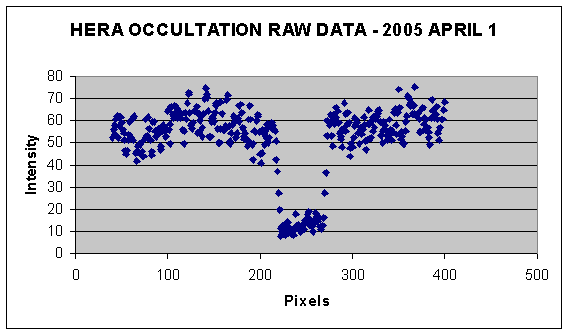A 7.1 second occultation was recorded using the CCD drift-scan technique by Bill Allen in Blenheim, New Zealand..
View the Updated Prediction
Drift-scan trace:

Derived Data:

Discussion:
The IRAS-estimated diameter of this asteroid is 91 km, corresponding to maximum expected duration of about 6.6 seconds. So Bill's occultation length of 7.1 seconds indicates that the asteroid is larger than this in at least one axis. Assuming that Bill might have seen an approximately central event, his observation also suggests that the path shifted north by perhaps one-half a track width.
Observational Data:
Observer's Name : Bill Allen
Aperture (cm) : 32 cm
Focal length (cm) : 224
Type (e.g. SCT; Newtonian) : Dall Kirkham, with a f3.3 focal reducer
Magnification :
Observing site name : Vintage Lane Observatory
Longitude (DD MM SS ; East +ve) : 173.85 E
Latitude (DD MM SS ; South -ve) : -41.50
Height above Sealevel (metres) : 30
Geodetic Datum (e.g.WGS84,NZ1949): NZ1949 (topographical map)
Height Datum (if known) : MSL
Sky Transparency (Delete two) : Good
Star Image Stability (Delete two): Good
Other Conditions:
(Wind, Clouds, Lights, etc.): No wind, clouded over 30 minutes after the event
Time Source (e.g. WWVH, GPS) : National time signals,Loader beeper synchronised manually to within 0.1 sec
Recording method (e.g. tape) : Drift Scan, time signals on tape
Could you see the Asteroid? : Yes
Approx. Limiting Magnitude : 16
| Estimated |
Universal Time | Reaction | Accuracy, Remarks
h m s | Time (sec) |
Started Observing : 16:42:49.1 n/a 0.2
Star and Object Merged : 16 06 50
Disappearance At : 16:43:08.2 n/a 0.3
Reappearance At : 16:43:15.3 n/a 0.3
Stopped Observing : 16:43:41.7 n/a 0.2
Duration : 7.1
ADDITIONAL COMMENTS: Time derived by John Broughton using his SCANALYSER software.
[Top of Page][Return to Home Page]